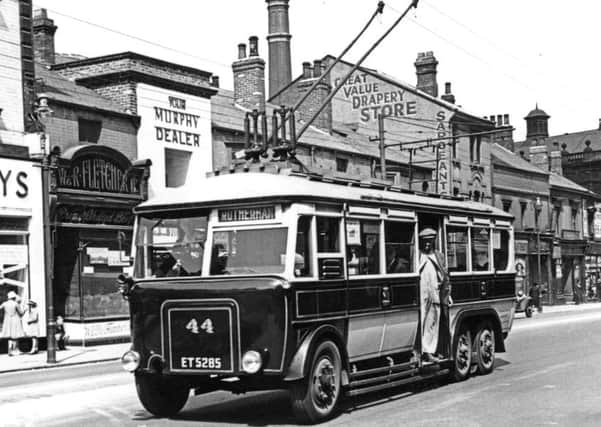Nostalgia on Tuesday: Trolley travel


The Leeds and Bradford trackless systems, the first in the UK, were opened together on June 20, 1911 and proved mechanically successful. Rotherham Corporation made history on Thursday, October 3, 1912 when introducing trolleybuses, or ‘trackless trams’, for the first time into South Yorkshire.
The Corporation’s trolleybus enterprise was an attempt to cope with a rapidly growing population particularly with a glut of mining developments in the area. At the trial runs in the week prior to the opening of the system, everything had gone smoothly. Those people privileged to ride described the motion as very even, and expressed surprise at the way in which the hills – and there were a few – were negotiated.
Advertisement
Hide AdAdvertisement
Hide AdThe new trolleybus route started at Broom Road, at the terminus of the ordinary trams, then passed through Wickersley and Bramley to Maltby – a distance of about 43 miles.
Initially, Rotherham’s trolleybuses were smaller than the average tramcar, did not have an upper deck and were wholly covered in, even the driver having protection from the weather.
Four cars (nos 38-41), each costing £725 and seating over 20 passengers, were acquired by Rotherham Corporation for use on the service.
A Board of Trade inspection of the route took place on September 30, 1912 and the scheme was approved. To instruct the Rotherham staff in trolley bus operation, Leeds Corporation provided one of their trolley drivers at a cost of £6 18s 3d.
Advertisement
Hide AdAdvertisement
Hide AdThere was a large turnout at the formal opening. Among those gathered in a marquee, where the speech-making took place, were the mayor and mayoress (Alderman PB and Mrs Coward), the deputy mayor and mayoress, the chairman of the Electric Light and Tramways Committee (Alderman D L Winter) and representatives from the Railless Electric Traction Construction Company (RET).
Sir Alex Gibbon, on behalf of the RET, presented Alderman Winter with an engraved gold matchbox. The mayor said that Mr Winter had taken a deep interest in the trolley route, spending months carrying through the scheme.
Responding to the compliment, Mr Winter said it was a very proud day. The question of trolleybuses was one to which he had given great consideration, and he had come to the following conclusion: “That as far as sparsely populated districts were concerned they were the best means of conveying people to their destinations available at that time.”
After Mr Winter received a vote of thanks, he led the way from the tent, switched on the current and then followed the loading-up of the cars.
Advertisement
Hide AdAdvertisement
Hide AdAfter the inaugural trip, the mayor presided at a luncheon served in the Town Hall Assembly Rooms. Seemingly, no expense was spared as the wine bill amounted to £37 14s 3d and food £42 2s 3d. The guests numbered about 170. Proposing success to the Rotherham trolleybus system, Lord Rotherham said he was quite sure everyone would wish that it ought to be an abundant and complete success.
The new route was designed to serve a population that was growing by leaps and bounds. It was also revealed that Alderman Winter, before suggesting trolleybuses for the town, had been a member of an important deputation which had visited quite a number of continental countries where trolleybus systems were operated.
Getting to his feet once more, Mr Winter was asked why they had not taken the system of ordinary trams right through from Rotherham to Maltby. His reply was that the initial cost was too great. The cost of extending the ordinary system would have amounted to £9,000 to £10,000 per mile whereas the cost of overhead equipment, apart from the outlay for trolleybuses, amounted to only £1,000 per mile.
The Rt Hon J A Pease MP said that he and the other guests had experienced a very interesting day. They had been not only through a lovely part of the country, and had ridden in very smooth-running and well-driven cars, but they had been sumptuously entertained. He added that efforts of this kind helped the tradespeople of the locality, enabled the poor to travel quickly to and from their work and permitted something to be done to remove the congestion of the large cities and towns by affording opportunity to breathe pure air, and thus lead healthier lives.
Advertisement
Hide AdAdvertisement
Hide AdAlso attending the luncheon was Alderman H Brown, the chairman of Leeds City Tramways Committee, who said it was quite true they in Leeds were the first to install the trolleybus system in this country, and that the system opened that day, in Rotherham, was far and away better than the one in Leeds.
As president of the Municipal Tramways Association, Mr AR Fearnley, of Sheffield, said he took the earliest opportunity of congratulating Rotherham upon the very fine system of trolley traction they had inaugurated. Without exception all members of the Association had great faith in this system of traction.
A year later, in 1913, Edward Cross, Rotherham’s borough electrical engineer, said it was possible to take a tramway from Mexborough right into Sheffield. He was satisfied that the Rotherham trolleys had provided a feeding effect upon local tramways.
Rotherham Corporation eventually introduced trolleybuses on other routes, replacing trams by 1949. There were 10 trolleybus routes serviced by a maximum fleet of 80 vehicles. Closure came on October 2, 1965. Three of the former Rotherham trolleybuses are now preserved.